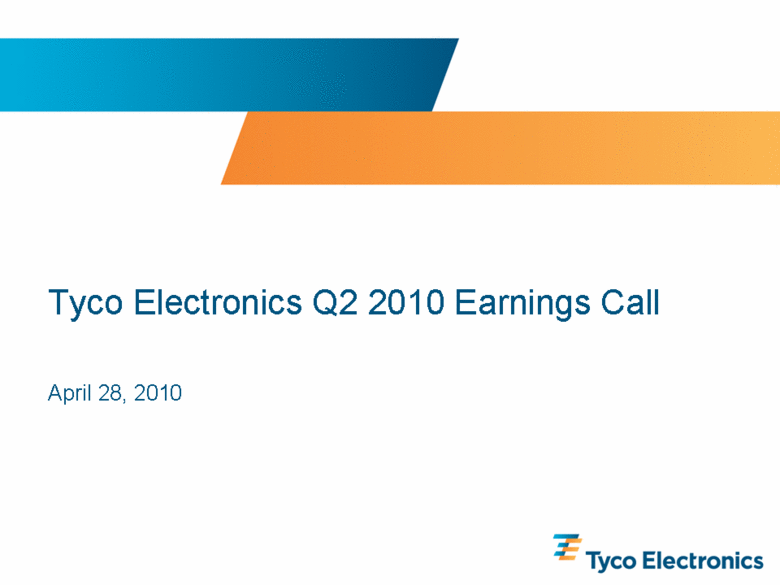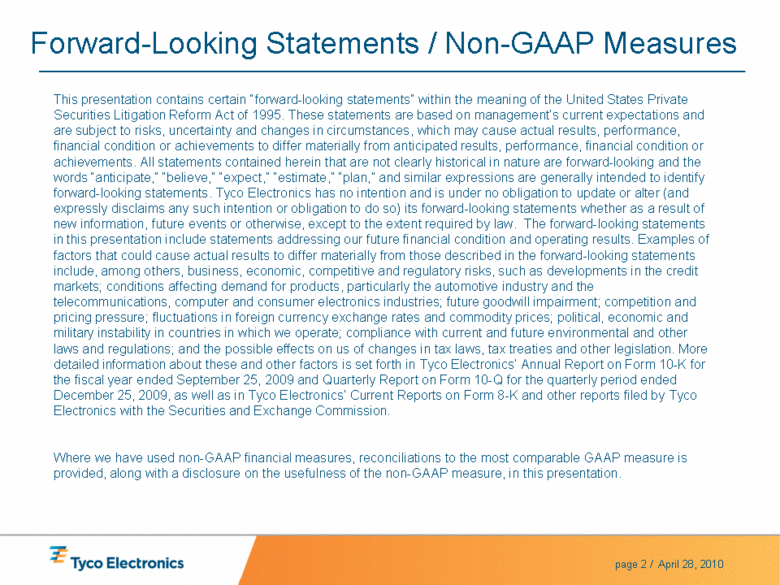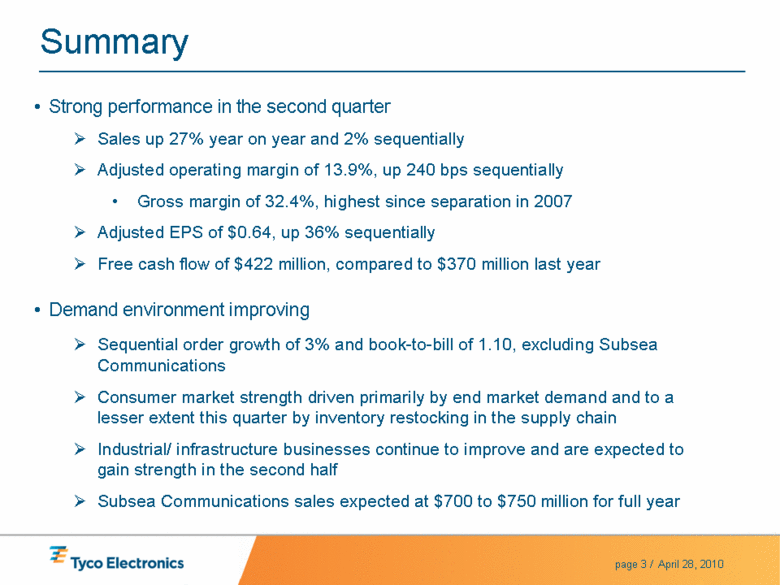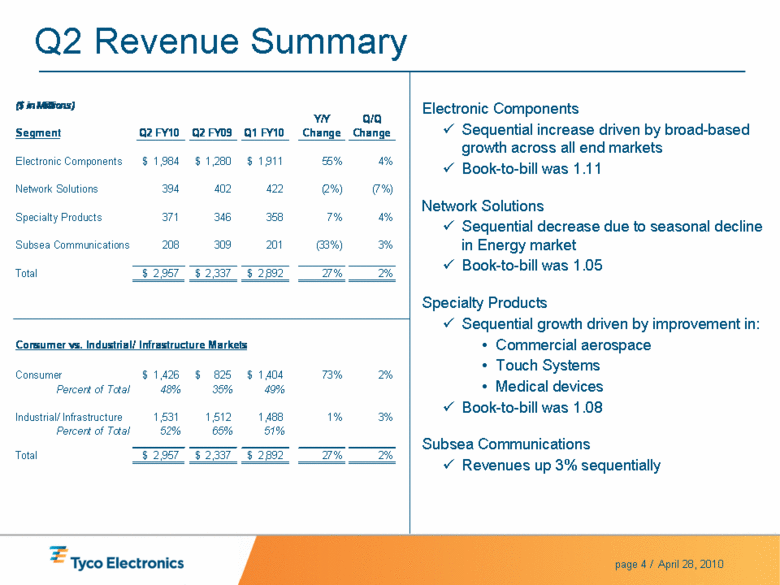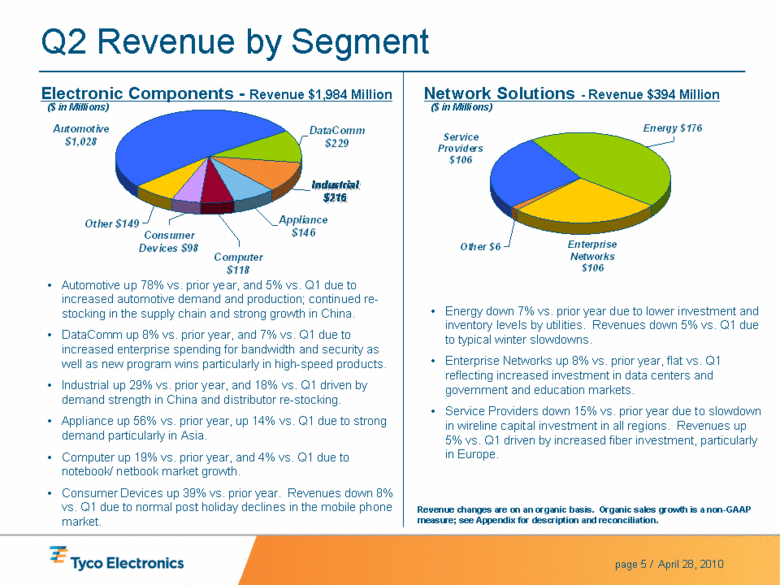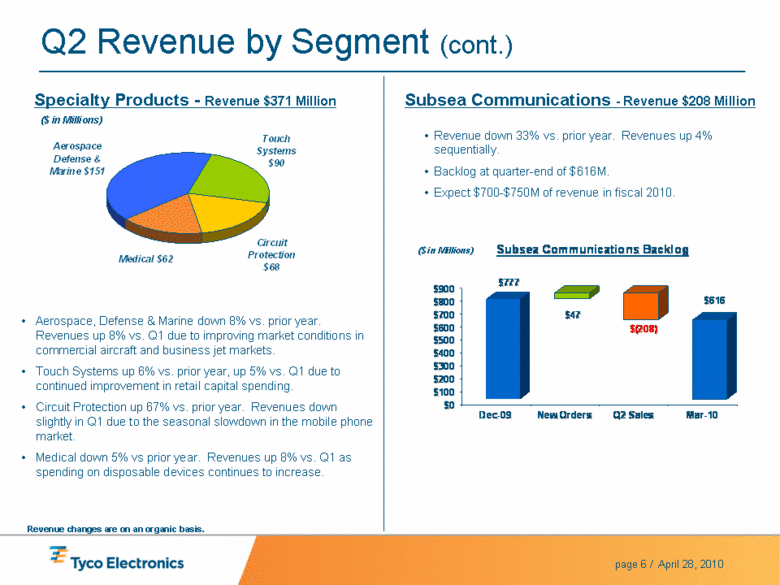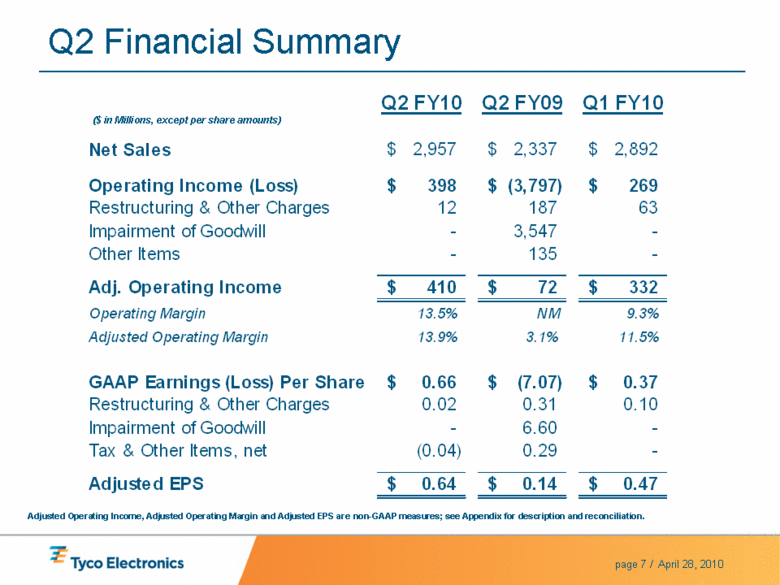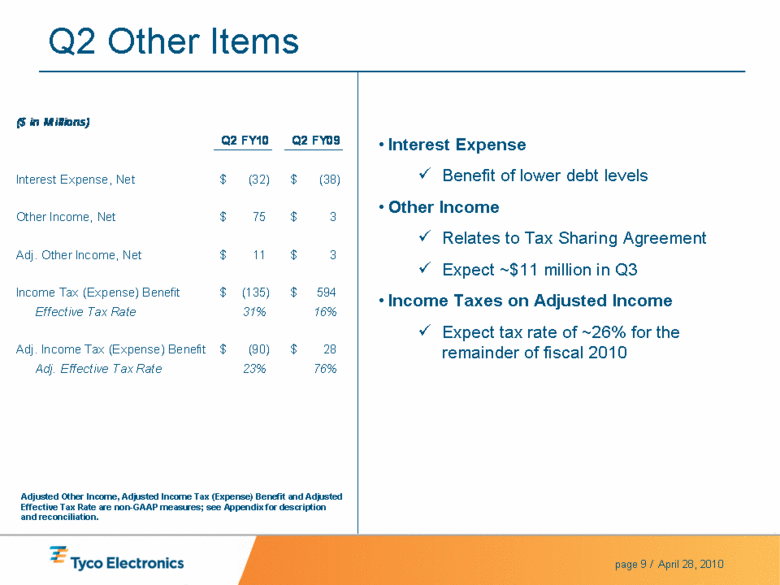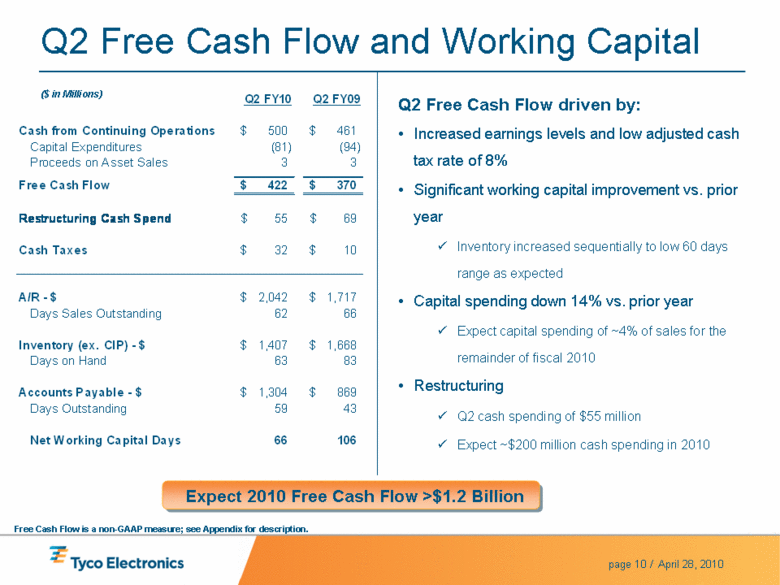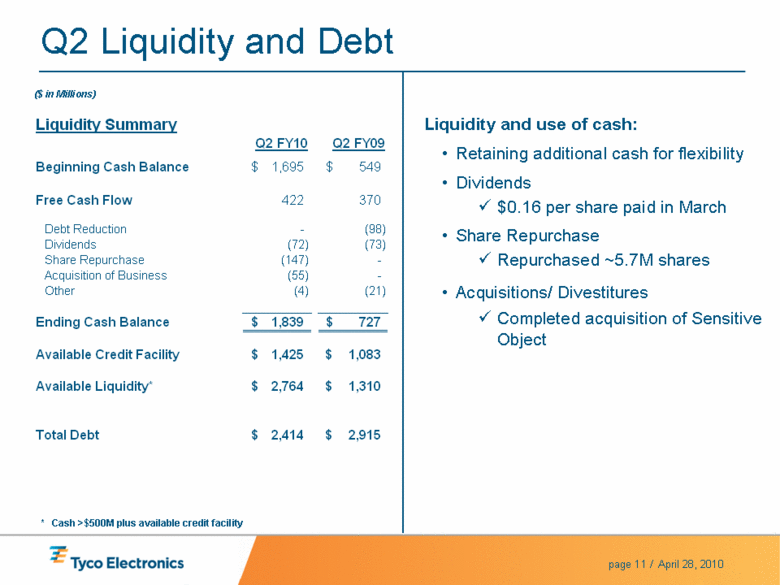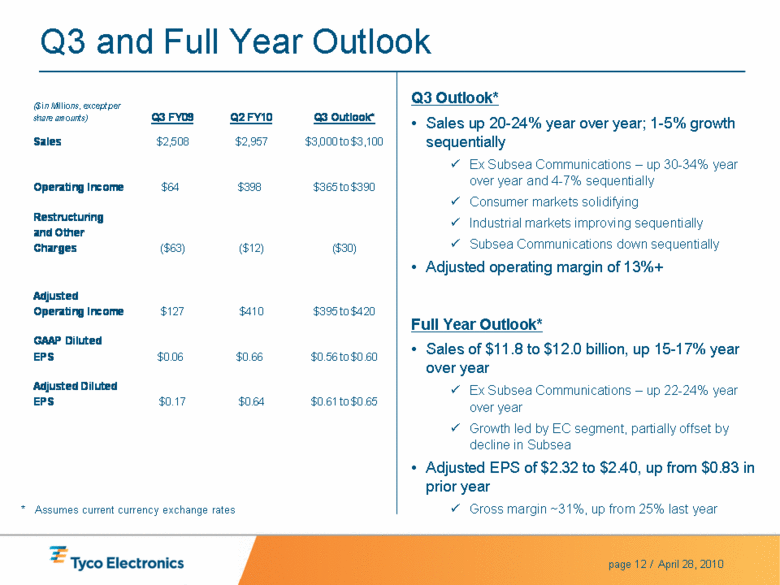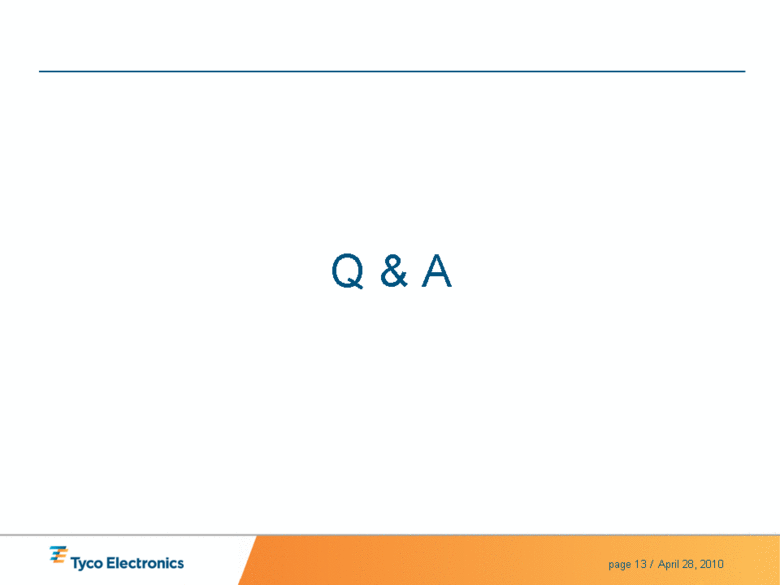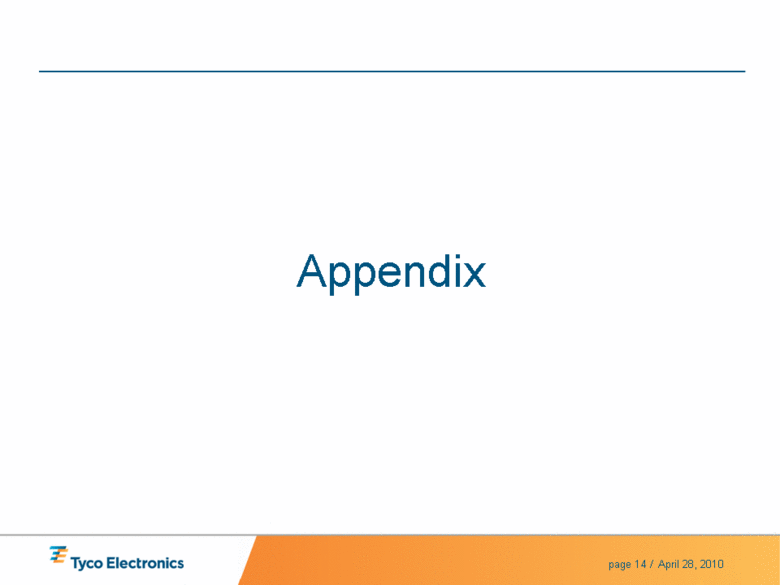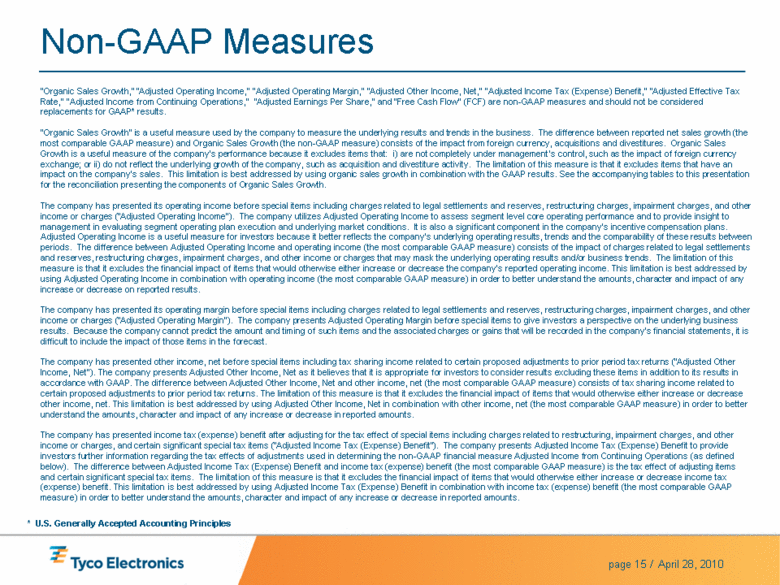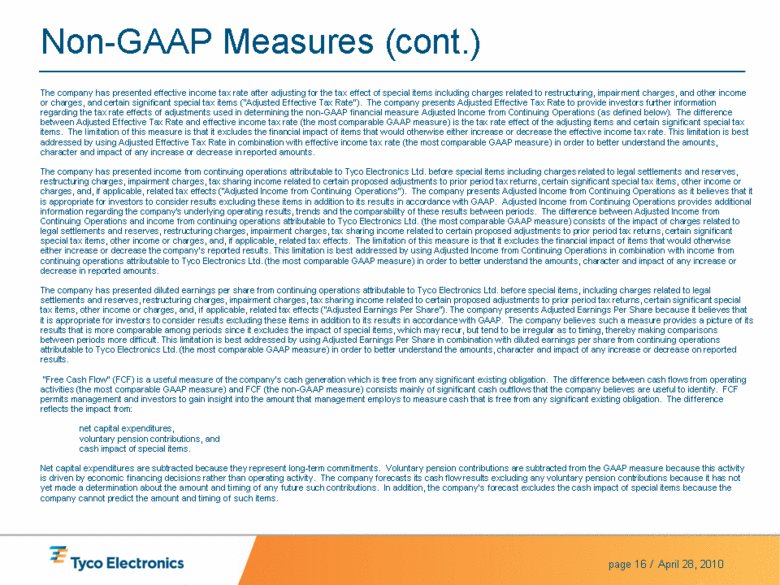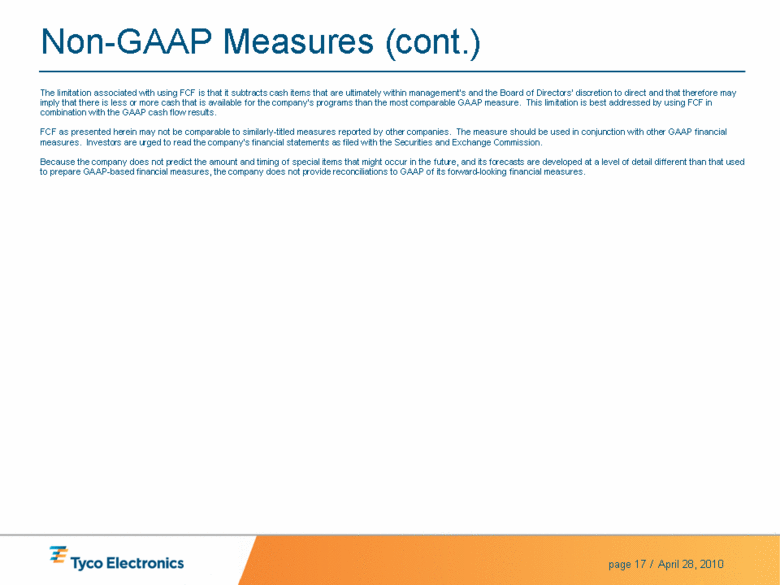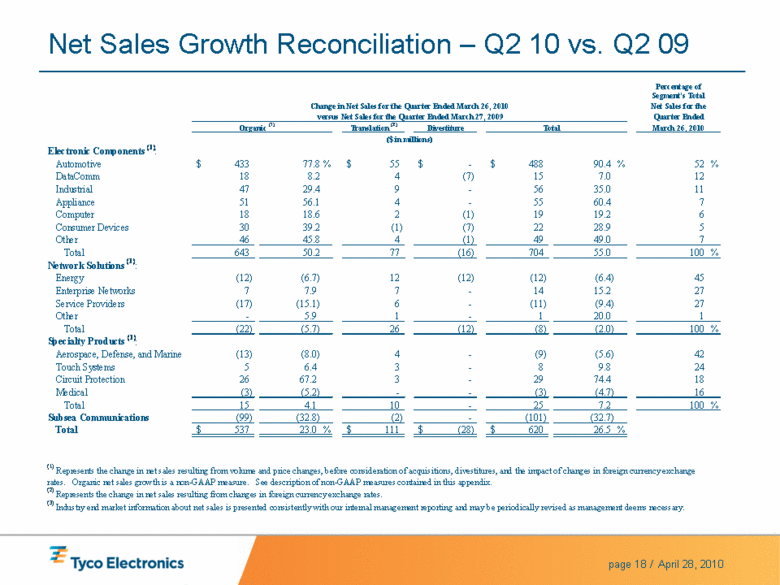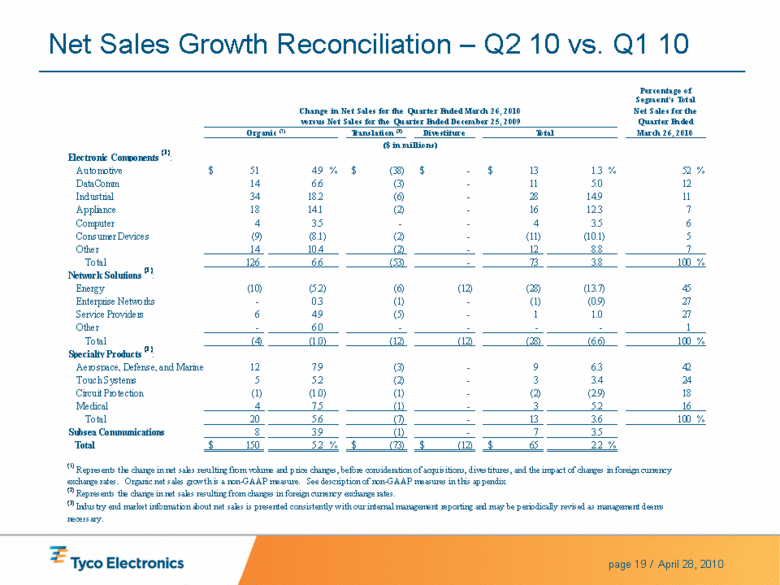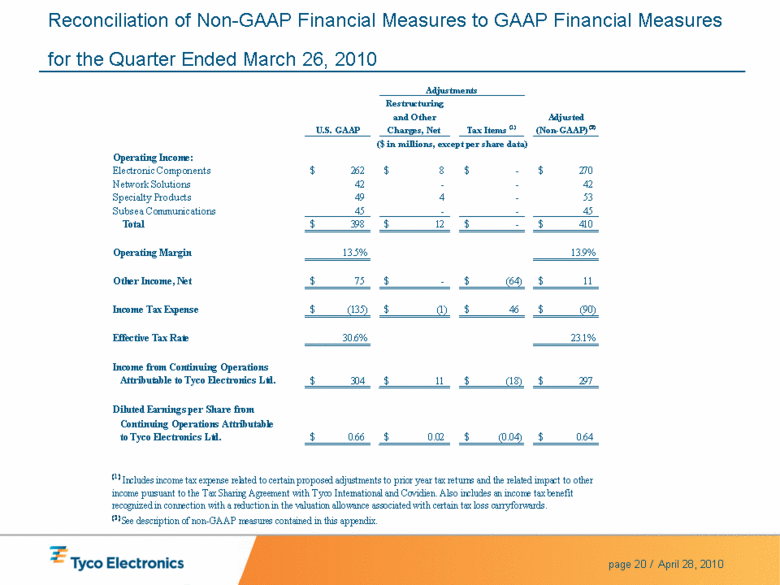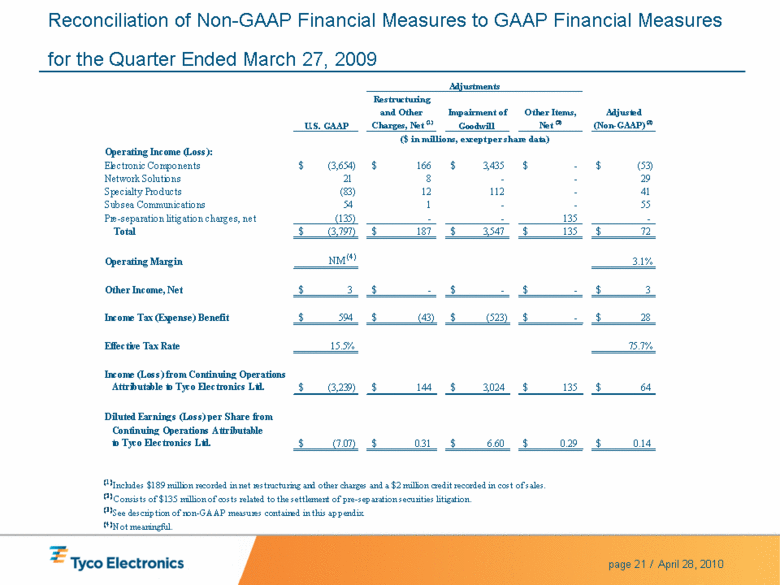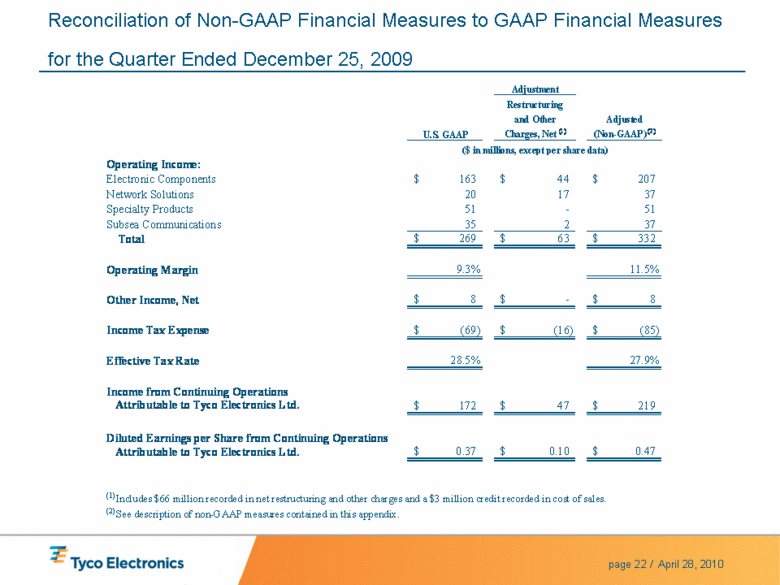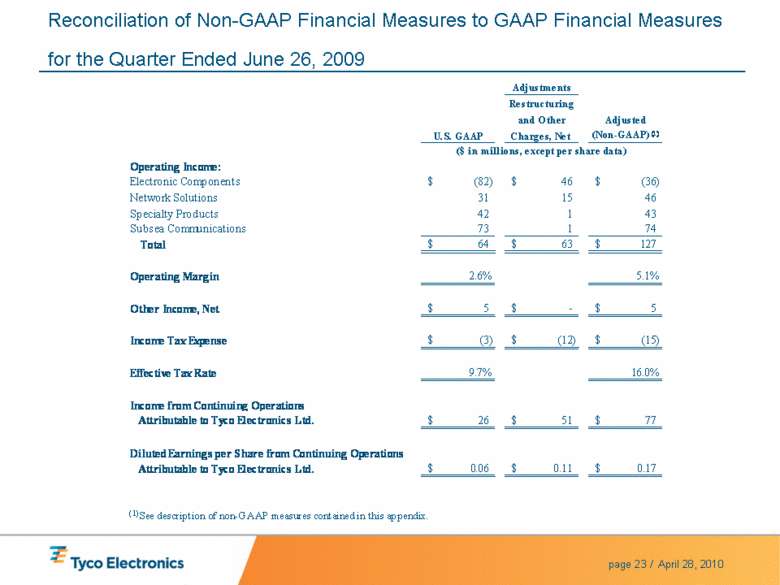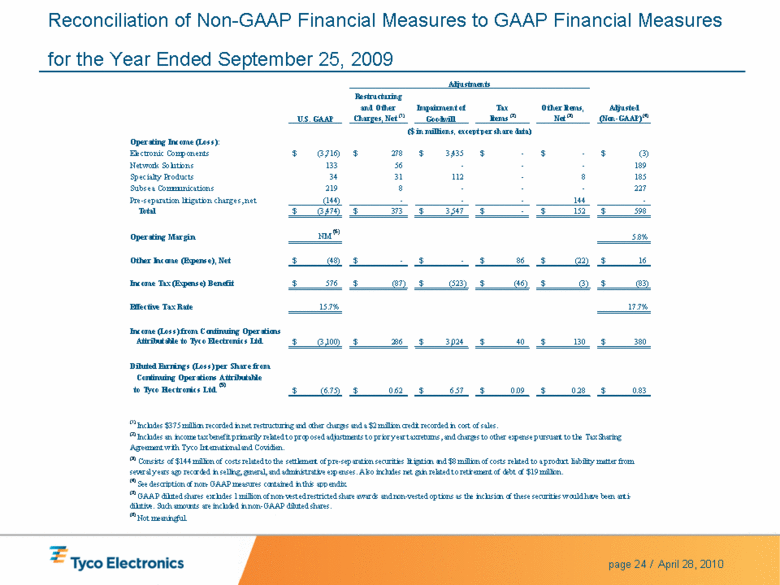Exhibit 99.2
| Tyco Electronics Q2 2010 Earnings Call April 28, 2010 |
| Forward-Looking Statements / Non-GAAP Measures This presentation contains certain “forward-looking statements” within the meaning of the United States Private Securities Litigation Reform Act of 1995. These statements are based on management’s current expectations and are subject to risks, uncertainty and changes in circumstances, which may cause actual results, performance, financial condition or achievements to differ materially from anticipated results, performance, financial condition or achievements. All statements contained herein that are not clearly historical in nature are forward-looking and the words “anticipate,” “believe,” “expect,” “estimate,” “plan,” and similar expressions are generally intended to identify forward-looking statements. Tyco Electronics has no intention and is under no obligation to update or alter (and expressly disclaims any such intention or obligation to do so) its forward-looking statements whether as a result of new information, future events or otherwise, except to the extent required by law. The forward-looking statements in this presentation include statements addressing our future financial condition and operating results. Examples of factors that could cause actual results to differ materially from those described in the forward-looking statements include, among others, business, economic, competitive and regulatory risks, such as developments in the credit markets; conditions affecting demand for products, particularly the automotive industry and the telecommunications, computer and consumer electronics industries; future goodwill impairment; competition and pricing pressure; fluctuations in foreign currency exchange rates and commodity prices; political, economic and military instability in countries in which we operate; compliance with current and future environmental and other laws and regulations; and the possible effects on us of changes in tax laws, tax treaties and other legislation. More detailed information about these and other factors is set forth in Tyco Electronics’ Annual Report on Form 10-K for the fiscal year ended September 25, 2009 and Quarterly Report on Form 10-Q for the quarterly period ended December 25, 2009, as well as in Tyco Electronics’ Current Reports on Form 8-K and other reports filed by Tyco Electronics with the Securities and Exchange Commission. Where we have used non-GAAP financial measures, reconciliations to the most comparable GAAP measure is provided, along with a disclosure on the usefulness of the non-GAAP measure, in this presentation. |
| Summary Strong performance in the second quarter Sales up 27% year on year and 2% sequentially Adjusted operating margin of 13.9%, up 240 bps sequentially Gross margin of 32.4%, highest since separation in 2007 Adjusted EPS of $0.64, up 36% sequentially Free cash flow of $422 million, compared to $370 million last year Demand environment improving Sequential order growth of 3% and book-to-bill of 1.10, excluding Subsea Communications Consumer market strength driven primarily by end market demand and to a lesser extent this quarter by inventory restocking in the supply chain Industrial/ infrastructure businesses continue to improve and are expected to gain strength in the second half Subsea Communications sales expected at $700 to $750 million for full year |
| Q2 Revenue Summary Electronic Components Sequential increase driven by broad-based growth across all end markets Book-to-bill was 1.11 Network Solutions Sequential decrease due to seasonal decline in Energy market Book-to-bill was 1.05 Specialty Products Sequential growth driven by improvement in: Commercial aerospace Touch Systems Medical devices Book-to-bill was 1.08 Subsea Communications Revenues up 3% sequentially $ 2,892 $ 2,337 $ 2,957 ($ in Millions) Segment Q2 FY10 Q2 FY09 Q1 FY10 Y/Y Change Q/Q Change Electronic Components $ 1,984 $ 1,280 $ 1,911 55% 4% Network Solutions 394 402 422 (2%) (7%) Specialty Products 371 346 358 7% 4% Subsea Communications 208 309 201 (33%) 3% Total $ 2,957 $ 2,337 $ 2,892 27% 2% Consumer vs. Industrial/ Infrastructure Markets Consumer $ 1,426 $ 825 $ 1,404 73% 2% Percent of Total 48% 35% 49% Industrial/ Infrastructure 1,531 1,512 1,488 1% 3% Percent of Total 52% 65% 51% Total 27% 2% |
| Q2 Revenue by Segment Electronic Components - Revenue $1,984 Million Network Solutions - Revenue $394 Million Automotive up 78% vs. prior year, and 5% vs. Q1 due to increased automotive demand and production; continued re-stocking in the supply chain and strong growth in China. DataComm up 8% vs. prior year, and 7% vs. Q1 due to increased enterprise spending for bandwidth and security as well as new program wins particularly in high-speed products. Industrial up 29% vs. prior year, and 18% vs. Q1 driven by demand strength in China and distributor re-stocking. Appliance up 56% vs. prior year, up 14% vs. Q1 due to strong demand particularly in Asia. Computer up 19% vs. prior year, and 4% vs. Q1 due to notebook/ netbook market growth. Consumer Devices up 39% vs. prior year. Revenues down 8% vs. Q1 due to normal post holiday declines in the mobile phone market. Energy down 7% vs. prior year due to lower investment and inventory levels by utilities. Revenues down 5% vs. Q1 due to typical winter slowdowns. Enterprise Networks up 8% vs. prior year, flat vs. Q1 reflecting increased investment in data centers and government and education markets. Service Providers down 15% vs. prior year due to slowdown in wireline capital investment in all regions. Revenues up 5% vs. Q1 driven by increased fiber investment, particularly in Europe. ($ in Millions) ($ in Millions) Revenue changes are on an organic basis. Organic sales growth is a non-GAAP measure; see Appendix for description and reconciliation. Other $6 Service Providers $106 Enterprise Networks $106 Energy $176 Automotive DataComm Industrial Appliance Computer Consumer Devices Other 2007 $1,028 $229 $216 $146 $118 $98 $149 |
| Specialty Products - Revenue $371 Million Subsea Communications - Revenue $208 Million Revenue down 33% vs. prior year. Revenues up 4% sequentially. Backlog at quarter-end of $616M. Expect $700-$750M of revenue in fiscal 2010. Q2 Revenue by Segment (cont.) Aerospace, Defense & Marine down 8% vs. prior year. Revenues up 8% vs. Q1 due to improving market conditions in commercial aircraft and business jet markets. Touch Systems up 6% vs. prior year, up 5% vs. Q1 due to continued improvement in retail capital spending. Circuit Protection up 67% vs. prior year. Revenues down slightly in Q1 due to the seasonal slowdown in the mobile phone market. Medical down 5% vs prior year. Revenues up 8% vs. Q1 as spending on disposable devices continues to increase. ($ in Millions) Revenue changes are on an organic basis. ($ in Millions) Medical $62 Aerospace Defense & Marine $151 Circuit Protection $68 Touch Systems $90 $777 $47 $616 $(208) $0 $100 $200 $300 $400 $500 $600 $700 $800 $900 Dec-09 New Orders Q2 Sales Mar-10 Subsea Communications Backlog |
| Q2 Financial Summary ($ in Millions, except per share amounts) Adjusted Operating Income, Adjusted Operating Margin and Adjusted EPS are non-GAAP measures; see Appendix for description and reconciliation. Q2 FY10 Q2 FY09 Q1 FY10 Net Sales $2,957 $2,337 $2,892 Operating Income (Loss) $398 $(3,797) $269 Restructuring & Other Charges 12 187 63 Impairment of Goodwill - 3,547 - Other Items - 135 - Adj. Operating Income $410 $72 $332 Operating Margin 13.5% NM 9.3% Adjusted Operating Margin 13.9% 3.1% 11.5% GAAP Earnings (Loss) Per Share $0.66 $(7.07) $0.37 Restructuring & Other Charges 0.02 0.31 0.10 Impairment of Goodwill - 6.60 - Tax & Other Items, net (0.04) 0.29 - Adjusted EPS $0.64 $0.14 $0.47 |
| Q2 Operating Results Gross Margin Performance Strong fall-through on volume increases in Electronic Components as a result of cost and footprint reductions in 2009 and productivity gains. Subsea gross margin benefitted overall gross margin by ~50 basis points due to favorable project execution Expect gross margin of ~31% for the remainder of fiscal 2010 Operating Expense Performance Operating Expenses up ~8% vs. Q1 due primarily to: Increased performance compensation costs Increased investment in R&D programs Expect RD&E of ~5% and SG&A of ~13% for the remainder of fiscal 2010 Q2 FY09 Q1 FY10 Q2 FY10 Gross Margin Percentage 20% 22% 24% 26% 28% 30% 32% 34% GM % 29% 30% 29% 28% 27% 23% 23% 26% 29% 32% Dec 2007 Mar 2008 Jun 2008 Sep 2008 Dec 2008 Mar 2009 Jun 2009 Sep 2009 Dec 2009 Mar 2010 ($ in Millions) Operating Expenses Q2 FY10 Q1 FY10 Q2 FY09 RD&E $142 $138 $131 SG&A 406 368 329 Total $548 $506 $460 % of Sales RD&E 4.8% 4.8% 5.6% SG&A 13.7% 12.7% 14.1% |
| Q2 Other Items Interest Expense Benefit of lower debt levels Other Income Relates to Tax Sharing Agreement Expect ~$11 million in Q3 Income Taxes on Adjusted Income Expect tax rate of ~26% for the remainder of fiscal 2010 Adjusted Other Income, Adjusted Income Tax (Expense) Benefit and Adjusted Effective Tax Rate are non-GAAP measures; see Appendix for description and reconciliation. ($ in Millions) Q2 FY10 Q2 FY09 Interest Expense, Net $(32) $(38) Other Income, Net $75 $3 Adj. Other Income, Net $11 $3 Income Tax (Expense) Benefit $(135) $594 Effective Tax Rate 31% 16% Adj. Income Tax (Expense) Benefit $(90) $28 Adj. Effective Tax Rate 23% 76% |
| Q2 Free Cash Flow and Working Capital Q2 Free Cash Flow driven by: Increased earnings levels and low adjusted cash tax rate of 8% Significant working capital improvement vs. prior year Inventory increased sequentially to low 60 days range as expected Capital spending down 14% vs. prior year Expect capital spending of ~4% of sales for the remainder of fiscal 2010 Restructuring Q2 cash spending of $55 million Expect ~$200 million cash spending in 2010 Expect 2010 Free Cash Flow >$1.2 Billion ($ in Millions) Free Cash Flow is a non-GAAP measure; see Appendix for description. Q2 FY10 Q2 FY09 Cash from Continuing Operations $500 $461 Capital Expenditures (81) 94 (94) Proceeds on Asset Sales 3 3 Free Cash Flow $422 $370 Restructuring Cash Spend $55 $69 Cash Taxes $32 $10 A/R - $ $2,042 $1,717 Days Sales Outstanding 62 66 Inventory (ex. CIP) - $ $1,407 $1,668 Days on Hand 63 83 Accounts Payable - $ $1,304 $869 Days Outstanding 59 43 Net Working Capital Days 66 106 |
| Q2 Liquidity and Debt * Cash >$500M plus available credit facility ($ in Millions) Liquidity and use of cash: Retaining additional cash for flexibility Dividends $0.16 per share paid in March Share Repurchase Repurchased ~5.7M shares Acquisitions/ Divestitures Completed acquisition of Sensitive Object Liquidity Summary Q2 FY10 Q2 FY09 Beginning Cash Balance $1,695 $549 Free Cash Flow 422 370 Debt Reduction - (98) Dividends (72) (73) Share Repurchase (147) - Acquisition of Business (55) - Other (4) (21) Ending Cash Balance $1,839 $727 Available Credit Facility $1,425 $1,083 Available Liquidity* $2,764 $1,310 Total Debt $2,414 $2,915 |
| Q3 and Full Year Outlook * Assumes current currency exchange rates Q3 Outlook* Sales up 20-24% year over year; 1-5% growth sequentially Ex Subsea Communications – up 30-34% year over year and 4-7% sequentially Consumer markets solidifying Industrial markets improving sequentially Subsea Communications down sequentially Adjusted operating margin of 13%+ Full Year Outlook* Sales of $11.8 to $12.0 billion, up 15-17% year over year Ex Subsea Communications – up 22-24% year over year Growth led by EC segment, partially offset by decline in Subsea Adjusted EPS of $2.32 to $2.40, up from $0.83 in prior year Gross margin ~31%, up from 25% last year $0.56 to $0.60 ($ in Millions, except per share amounts) Q3 FY09 Q2 FY10 Q3 Outlook* Sales $2,508 $2,957 $3,000 to $3,100 Operating Income $64 $398 $365 to $390 Restructuring and Other Charges ($63) ($12) ($30) Adjusted Operating Income $127 $410 $395 to $420 GAAP Diluted EPS $0.06 $0.66 $0.56 to $0.60 Adjusted Diluted EPS $0.17 $0.64 $0.61 to $0.65 |
| Q & A |
| Appendix |
| Non-GAAP Measures “Organic Sales Growth,” “Adjusted Operating Income,” “Adjusted Operating Margin,” “Adjusted Other Income, Net,” “Adjusted Income Tax (Expense) Benefit,” “Adjusted Effective Tax Rate,” “Adjusted Income from Continuing Operations,” “Adjusted Earnings Per Share,” and “Free Cash Flow” (FCF) are non-GAAP measures and should not be considered replacements for GAAP* results. “Organic Sales Growth” is a useful measure used by the company to measure the underlying results and trends in the business. The difference between reported net sales growth (the most comparable GAAP measure) and Organic Sales Growth (the non-GAAP measure) consists of the impact from foreign currency, acquisitions and divestitures. Organic Sales Growth is a useful measure of the company’s performance because it excludes items that: i) are not completely under management’s control, such as the impact of foreign currency exchange; or ii) do not reflect the underlying growth of the company, such as acquisition and divestiture activity. The limitation of this measure is that it excludes items that have an impact on the company’s sales. This limitation is best addressed by using organic sales growth in combination with the GAAP results. See the accompanying tables to this presentation for the reconciliation presenting the components of Organic Sales Growth. The company has presented its operating income before special items including charges related to legal settlements and reserves, restructuring charges, impairment charges, and other income or charges (“Adjusted Operating Income”). The company utilizes Adjusted Operating Income to assess segment level core operating performance and to provide insight to management in evaluating segment operating plan execution and underlying market conditions. It is also a significant component in the company’s incentive compensation plans. Adjusted Operating Income is a useful measure for investors because it better reflects the company’s underlying operating results, trends and the comparability of these results between periods. The difference between Adjusted Operating Income and operating income (the most comparable GAAP measure) consists of the impact of charges related to legal settlements and reserves, restructuring charges, impairment charges, and other income or charges that may mask the underlying operating results and/or business trends. The limitation of this measure is that it excludes the financial impact of items that would otherwise either increase or decrease the company’s reported operating income. This limitation is best addressed by using Adjusted Operating Income in combination with operating income (the most comparable GAAP measure) in order to better understand the amounts, character and impact of any increase or decrease on reported results. The company has presented its operating margin before special items including charges related to legal settlements and reserves, restructuring charges, impairment charges, and other income or charges (“Adjusted Operating Margin”). The company presents Adjusted Operating Margin before special items to give investors a perspective on the underlying business results. Because the company cannot predict the amount and timing of such items and the associated charges or gains that will be recorded in the company’s financial statements, it is difficult to include the impact of those items in the forecast. The company has presented other income, net before special items including tax sharing income related to certain proposed adjustments to prior period tax returns (“Adjusted Other Income, Net”). The company presents Adjusted Other Income, Net as it believes that it is appropriate for investors to consider results excluding these items in addition to its results in accordance with GAAP. The difference between Adjusted Other Income, Net and other income, net (the most comparable GAAP measure) consists of tax sharing income related to certain proposed adjustments to prior period tax returns. The limitation of this measure is that it excludes the financial impact of items that would otherwise either increase or decrease other income, net. This limitation is best addressed by using Adjusted Other Income, Net in combination with other income, net (the most comparable GAAP measure) in order to better understand the amounts, character and impact of any increase or decrease in reported amounts. The company has presented income tax (expense) benefit after adjusting for the tax effect of special items including charges related to restructuring, impairment charges, and other income or charges, and certain significant special tax items (“Adjusted Income Tax (Expense) Benefit”). The company presents Adjusted Income Tax (Expense) Benefit to provide investors further information regarding the tax effects of adjustments used in determining the non-GAAP financial measure Adjusted Income from Continuing Operations (as defined below). The difference between Adjusted Income Tax (Expense) Benefit and income tax (expense) benefit (the most comparable GAAP measure) is the tax effect of adjusting items and certain significant special tax items. The limitation of this measure is that it excludes the financial impact of items that would otherwise either increase or decrease income tax (expense) benefit. This limitation is best addressed by using Adjusted Income Tax (Expense) Benefit in combination with income tax (expense) benefit (the most comparable GAAP measure) in order to better understand the amounts, character and impact of any increase or decrease in reported amounts. * U.S. Generally Accepted Accounting Principles |
| Non-GAAP Measures (cont.) The company has presented effective income tax rate after adjusting for the tax effect of special items including charges related to restructuring, impairment charges, and other income or charges, and certain significant special tax items (“Adjusted Effective Tax Rate”). The company presents Adjusted Effective Tax Rate to provide investors further information regarding the tax rate effects of adjustments used in determining the non-GAAP financial measure Adjusted Income from Continuing Operations (as defined below). The difference between Adjusted Effective Tax Rate and effective income tax rate (the most comparable GAAP measure) is the tax rate effect of the adjusting items and certain significant special tax items. The limitation of this measure is that it excludes the financial impact of items that would otherwise either increase or decrease the effective income tax rate. This limitation is best addressed by using Adjusted Effective Tax Rate in combination with effective income tax rate (the most comparable GAAP measure) in order to better understand the amounts, character and impact of any increase or decrease in reported amounts. The company has presented income from continuing operations attributable to Tyco Electronics Ltd. before special items including charges related to legal settlements and reserves, restructuring charges, impairment charges, tax sharing income related to certain proposed adjustments to prior period tax returns, certain significant special tax items, other income or charges, and, if applicable, related tax effects (“Adjusted Income from Continuing Operations”). The company presents Adjusted Income from Continuing Operations as it believes that it is appropriate for investors to consider results excluding these items in addition to its results in accordance with GAAP. Adjusted Income from Continuing Operations provides additional information regarding the company’s underlying operating results, trends and the comparability of these results between periods. The difference between Adjusted Income from Continuing Operations and income from continuing operations attributable to Tyco Electronics Ltd. (the most comparable GAAP measure) consists of the impact of charges related to legal settlements and reserves, restructuring charges, impairment charges, tax sharing income related to certain proposed adjustments to prior period tax returns, certain significant special tax items, other income or charges, and, if applicable, related tax effects. The limitation of this measure is that it excludes the financial impact of items that would otherwise either increase or decrease the company’s reported results. This limitation is best addressed by using Adjusted Income from Continuing Operations in combination with income from continuing operations attributable to Tyco Electronics Ltd. (the most comparable GAAP measure) in order to better understand the amounts, character and impact of any increase or decrease in reported amounts. The company has presented diluted earnings per share from continuing operations attributable to Tyco Electronics Ltd. before special items, including charges related to legal settlements and reserves, restructuring charges, impairment charges, tax sharing income related to certain proposed adjustments to prior period tax returns, certain significant special tax items, other income or charges, and, if applicable, related tax effects (“Adjusted Earnings Per Share”). The company presents Adjusted Earnings Per Share because it believes that it is appropriate for investors to consider results excluding these items in addition to its results in accordance with GAAP. The company believes such a measure provides a picture of its results that is more comparable among periods since it excludes the impact of special items, which may recur, but tend to be irregular as to timing, thereby making comparisons between periods more difficult. This limitation is best addressed by using Adjusted Earnings Per Share in combination with diluted earnings per share from continuing operations attributable to Tyco Electronics Ltd. (the most comparable GAAP measure) in order to better understand the amounts, character and impact of any increase or decrease on reported results. “Free Cash Flow” (FCF) is a useful measure of the company’s cash generation which is free from any significant existing obligation. The difference between cash flows from operating activities (the most comparable GAAP measure) and FCF (the non-GAAP measure) consists mainly of significant cash outflows that the company believes are useful to identify. FCF permits management and investors to gain insight into the amount that management employs to measure cash that is free from any significant existing obligation. The difference reflects the impact from: net capital expenditures, voluntary pension contributions, and cash impact of special items. Net capital expenditures are subtracted because they represent long-term commitments. Voluntary pension contributions are subtracted from the GAAP measure because this activity is driven by economic financing decisions rather than operating activity. The company forecasts its cash flow results excluding any voluntary pension contributions because it has not yet made a determination about the amount and timing of any future such contributions. In addition, the company’s forecast excludes the cash impact of special items because the company cannot predict the amount and timing of such items. |
| Non-GAAP Measures (cont.) The limitation associated with using FCF is that it subtracts cash items that are ultimately within management’s and the Board of Directors’ discretion to direct and that therefore may imply that there is less or more cash that is available for the company's programs than the most comparable GAAP measure. This limitation is best addressed by using FCF in combination with the GAAP cash flow results. FCF as presented herein may not be comparable to similarly-titled measures reported by other companies. The measure should be used in conjunction with other GAAP financial measures. Investors are urged to read the company’s financial statements as filed with the Securities and Exchange Commission. Because the company does not predict the amount and timing of special items that might occur in the future, and its forecasts are developed at a level of detail different than that used to prepare GAAP-based financial measures, the company does not provide reconciliations to GAAP of its forward-looking financial measures. |
| Net Sales Growth Reconciliation – Q2 10 vs. Q2 09 (3) Industry end market information about net sales is presented consistently with our internal management reporting and may be periodically revised as management deems necessary. (2) Represents the change in net sales resulting from changes in foreign currency exchange rates. (1) Represents the change in net sales resulting from volume and price changes, before consideration of acquisitions, divestitures, and the impact of changes in foreign currency exchange rates. Organic net sales growth is a non-GAAP measure. See descr % 26.5 $ 620 $ (28) $ 111 % 23.0 $ 537 Total (32.7) (101) - (2) (32.8) (99) Subsea Communications % 100 7.2 25 - 10 4.1 15 Total 16 (4.7) (3) - - (5.2) (3) Medical 18 74.4 29 - 3 67.2 26 Circuit Protection 24 9.8 8 - 3 6.4 5 Touch Systems 42 (5.6) (9) - 4 (8.0) (13) Aerospace, Defense, and Marine Specialty Products (3): % 100 (2.0) (8) (12) 26 (5.7) (22) Total 1 20.0 1 - 1 5.9 - Other 27 (9.4) (11) - 6 (15.1) (17) Service Providers 27 15.2 14 - 7 7.9 7 Enterprise Networks 45 (6.4) (12) (12) 12 (6.7) (12) Energy Network Solutions (3): % 100 55.0 704 (16) 77 50.2 643 Total 7 49.0 49 (1) 4 45.8 46 Other 5 28.9 22 (7) (1) 39.2 30 Consumer Devices 6 19.2 19 (1) 2 18.6 18 Computer 7 60.4 55 - 4 56.1 51 Appliance 11 35.0 56 - 9 29.4 47 Industrial 12 7.0 15 (7) 4 8.2 18 DataComm % 52 % 90.4 $ 488 $ - $ 55 % 77.8 $ 433 Automotive Electronic Components (3): ($ in millions) March 26, 2010 Total Divestiture Translation (2) Organic (1) Quarter Ended versus Net Sales for the Quarter Ended March 27, 2009 Net Sales for the Change in Net Sales for the Quarter Ended March 26, 2010 Segment's Total Percentage of |
| Net Sales Growth Reconciliation – Q2 10 vs. Q1 10 (2) Represents the change in net sales resulting from changes in foreign currency exchange rates. Percentage of Segment's Total Change in Net Sales for the Quarter Ended March 26, 2010 Net Sales for the versus Net Sales for the Quarter Ended December 25, 2009 Quarter Ended Organic (1) Translation (2) Divestiture Total March 26, 2010 ($ in millions) Electronic Components (3): Automotive $51 4.9 % $(38) $- $13 1.3 % 52 % DataComm 14 6.6 (3) - 11 5.0 12 Industrial 34 18.2 (6) - 28 14.9 11 Appliance 18 14.1 (2) - 16 12.3 7 Computer 4 3.5 - - 4 3.5 6 Consumer Devices (9) (8.1) (2) - (11) (10.1) 5 Other 14 10.4 (2) - 12 8.8 7 Total 126 6.6 (53) - 73 3.8 100 % Network Solutions (3): Energy (10) (5.2) (6) (12) (28) (13.7) 45 Enterprise Networks - 0.3 (1) - (1) (0.9) 27 Service Providers 6 4.9 (5) - 1 1.0 27 Other - 6.0 - - - - 1 Total (4) (1.0) (12) (12) (28) (6.6) 100 % Specialty Products (3): Aerospace, Defense, and Marine 12 7.9 (3) - 9 6.3 42 Touch Systems 5 5.2 (2) - 3 3.4 24 Circuit Protection (1) (1.0) (1) - (2) (2.9) 18 Medical 4 7.5 (1) - 3 5.2 16 Total 20 5.6 (7) - 13 3.6 100 % Subsea Communications 8 3.9 (1) - 7 3.5 Total $150 5.2 % $(73) $(12) $65 2.2 % (1) Represents the change in net sales resulting from volume and price changes, before consideration of acquisitions, divestitures, and the impact of changes in foreign currency exchange rates. Organic net sales growth is a non-GAAP measure. See description of non-GAAP measures in this appendix. (3) Industry end market information about net sales is presented consistently with our internal management reporting and may be periodically revised as management deems necessary. |
| Reconciliation of Non-GAAP Financial Measures to GAAP Financial Measures for the Quarter Ended March 26, 2010 (1) Includes income tax expense related to certain proposed adjustments to prior year tax returns and the related impact to other income pursuant to the Tax Sharing Agreement with Tyco International and Covidien. Also includes an income tax benefit recognized in connection with a reduction in the valuation allowance associated with certain tax loss carryforwards. Adjustments Restructuring and Other Adjusted U.S. GAAP Charges, Net Tax Items (1) (Non-GAAP) (2) ($ in millions, except per share data) Operating Income: Electronic Components $262 $8 $- $270 Network Solutions 42 - - 42 Specialty Products 49 4 - 53 Subsea Communications 45 - - 45 Total $398 $12 $- $410 Operating Margin 13.5% 13.9% Other Income, Net $75 $- $(64) $11 Income Tax Expense $(135) $(1) $46 $(90) Effective Tax Rate 30.6% 23.1% Income from Continuing Operations Attributable to Tyco Electronics Ltd. $304 $11 $(18) $297 Diluted Earnings per Share from Continuing Operations Attributable to Tyco Electronics Ltd. $0.66 $0.02 $(0.04) $0.64 (2) See description of non-GAAP measures contained in this appendix. |
| Reconciliation of Non-GAAP Financial Measures to GAAP Financial Measures for the Quarter Ended March 27, 2009 Income (Loss) from Continuing Operations Adjustments Restructuring and Other Impairment of Other Items, Adjusted U.S. GAAP Charges, Net (1) Goodwill Net (2) (Non-GAAP) (3) ($ in millions, except per share data) Operating Income (Loss): Electronic Components $(3,654) $166 $3,435 $- $(53) Network Solutions 21 8 - - 29 Specialty Products (83) 12 112 - 41 Subsea Communications 54 1 - - 55 Pre-separation litigation charges, net (135) - - 135 - Total $(3,797) $187 $3,547 $135 $72 Operating Margin NM (4) 3.1% Other Income, Net $3 $- $- $- $3 Income Tax (Expense) Benefit $594 $(43) $(523) $- $28 Effective Tax Rate 15.5% 75.7% Income (Loss) from Continuing Operations Attributable to Tyco Electronics Ltd. $(3,239) $144 $3,024 $135 $64 Diluted Earnings (Loss) per Share from Continuing Operations Attributable to Tyco Electronics Ltd. $(7.07) $0.31 $6.60 $0.29 $0.14 (1) Includes $189 million recorded in net restructuring and other charges and a $2 million credit recorded in cost of sales. (2) Consists of $135 million of costs related to the settlement of pre-separation securities litigation. (3) See description of non-GAAP measures contained in this appendix. (4) Not meaningful. |
| Reconciliation of Non-GAAP Financial Measures to GAAP Financial Measures for the Quarter Ended December 25, 2009 (2) See description of non-GAAP measures contained in this appendix. (1) Includes $66 million recorded in net restructuring and other charges and a $3 million credit recorded in cost of sales. $ 0.47 $ 0.10 $ 0.37 Attributable to Tyco Electronics Ltd. Diluted Earnings per Share from Continuing Operations $ 219 $ 47 $ 172 Attributable to Tyco Electronics Ltd. Income from Continuing Operations 27.9% 28.5% Effective Tax Rate $ (85) $ (16) $ (69) Income Tax Expense $ 8 $ - $ 8 Other Income, Net 11.5% 9.3% Operating Margin $ 332 $ 63 $ 269 Total 37 2 35 Subsea Communications 51 - 51 Specialty Products 37 17 20 Network Solutions $ 207 $ 44 $ 163 Electronic Components Operating Income: ($ in millions, except per share data) (Non-GAAP) (2) Charges, Net (1) U.S. GAAP Adjusted and Other Restructuring Adjustment |
| Reconciliation of Non-GAAP Financial Measures to GAAP Financial Measures for the Quarter Ended June 26, 2009 Adjustments Restructuring and Other Adjusted U.S. GAAP Charges, Net (Non-GAAP) (1) ($ in millions, except per share data) Operating Income: Electronic Components $(82) $46 $(36) Network Solutions 31 15 46 Specialty Products 42 1 43 Subsea Communications 73 1 74 Total $64 $63 $127 Operating Margin 2.6% 5.1% Other Income, Net $5 $- $5 Income Tax Expense $(3) $(12) $(15) Effective Tax Rate 9.7% 16.0% Income from Continuing Operations Attributable to Tyco Electronics Ltd. $26 $51 $77 Diluted Earnings per Share from Continuing Operations Attributable to Tyco Electronics Ltd. $0.06 $0.11 $0.17 (1) See description of non-GAAP measures contained in this appendix. |
| Reconciliation of Non-GAAP Financial Measures to GAAP Financial Measures for the Year Ended September 25, 2009 (4) See description of non-GAAP measures contained in this appendix. Adjustments Restructuring and Other Impairment of Tax Other Items, Adjusted U.S. GAAP Charges, Net (1) Goodwill Items (2) Net (3) (Non-GAAP) (4) ($ in millions, except per share data) Operating Income (Loss): Electronic Components $(3,716) $278 $3,435 $- $- $(3) Network Solutions 133 56 - - - 189 Specialty Products 34 31 112 - 8 185 Subsea Communications 219 8 - - - 227 Pre-separation litigation charges, net (144) - - - 144 - Total $(3,474) $373 $3,547 $- $152 $598 Operating Margin NM (6) 5.8% Other Income (Expense), Net $(48) $- $- $86 $(22) $16 Income Tax (Expense) Benefit $576 $(87) $(523) $(46) $(3) $(83) Effective Tax Rate 15.7% 17.7% Income (Loss) from Continuing Operations Attributable to Tyco Electronics Ltd. $(3,100) $286 $3,024 $40 $130 $380 Diluted Earnings (Loss) per Share from Continuing Operations Attributable to Tyco Electronics Ltd. (5) $(6.75) $0.62 $6.57 $0.09 $0.28 $0.83 (1) Includes $375 million recorded in net restructuring and other charges and a $2 million credit recorded in cost of sales. (2) Includes an income tax benefit primarily related to proposed adjustments to prior year tax returns, and charges to other expense pursuant to the Tax Sharing Agreement with Tyco International and Covidien. (3) Consists of $144 million of costs related to the settlement of pre-separation securities litigation and $8 million of costs related to a product liability matter from several years ago recorded in selling, general, and administrative expenses. Also includes net gain related to retirement of debt of $19 million. (4) See description of non-GAAP measures contained in this appendix. (5) GAAP diluted shares excludes 1 million of non-vested restricted share awards and non-vested options as the inclusion of these securities would have been anti-dilutive. Such amounts are included in non-GAAP diluted shares. (6) Not meaningful. |
